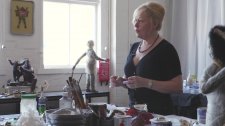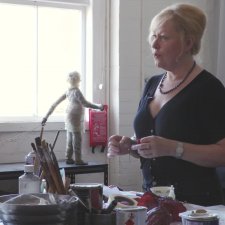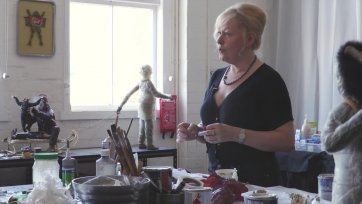Five hundred and fifty-five bones in four different colours. What a nice set of numbers.
I went down to the Antarctic and I went with my friend Zoe Davis. We were fortunate enough to go down on a ship called Orion. On the way back, we picked up some scientists that were coming back from their work commute. So I've remade those four scientists and botanists. Of the scientists, Kate and Dana and Jack and Marilyn. When I got started on this, I was speaking with my friend Dana and I said, "Oh, I've given all my scientists the attributes of four major animals that you'd find in the Antarctic. Which one do you reckon you are?" She picked herself straight away as a penguin and then we went through and she actually picked the others. So we've got a leopard seal, a penguin, a killer whale, an albatross, and the two girls that just strung along for the trip.
The materials that I'm mainly using in these works are skin, viscera, so internal skin, and bone. I'm using casts of a lot of bones because some bones are just a bit too awkward to handle, and so I have pretty much a casting library. Some of the bones that I've cast for these works range from human bones, leg bones, and vertebrae, down to tiny weeny snake bones. There's one particular bone that I've used. I've used it making a sled and it's just found here in the neck of a chicken. I've used a really geometric pattern so I could grid it up and count it and I've dyed them different colours, and it was a way of introducing a bit of colour into an otherwise very black, white, and brown pallet for these works.
It's been a really nice thing to be working with. It's been a very nice change. My last body of work about the Antarctic was all bone and fibre whereas this is skin and bone, gut. I've welded up armatures that are inside each of these figures. So they've got steel armatures inside them. I use my bone library here. So for bones that I can't have and don't really exist for me, I can model them and fabricate them in my studio. I make a two-piece mold and I use different types of materials in the mold so there's a heavy casting component. And actually, I have used human teeth in Jack, in the leopard seal.
The albatross has beautiful pearls and little bones, and the penguin over here has beautiful old fox fur boots and gloves and she has the remains of one of our Christmas meals and turkey bones and carnelian eyes, osprey feathers. They've got something that's a little bit precious about it and for me, the smoky quartz or the carnelian or citrines are just as precious as the peacock feathers, albino peacock feathers. What Jack has is he's got some precious stone eyes. He's got some really beautiful cushion-cut citrines but he's also got a knitted pair of socks so he's got the element of metal. So he's got some knitted socks and a knitted jumper which probably won't keep him that warm down there.
I've kept a sketchbook for this body of work. These are sort of like their ultrasounds. I draw most days and I certainly draw all my works, if not before I make them, I draw them afterwards sort of as family portraits. With each of the portraits I’ll give a materials list, measurements. So even if I don't have the work living with me here in the studio, I've still got illustrations of them. It's like their birth certificate, I guess.
They're joyful and they're excited works, and they couldn't be anything but that. I've still got a lot more to go with this. I love it and I'm now at the end of this body of work and I just see where I want it to take me with more colour and more applications with the material.









